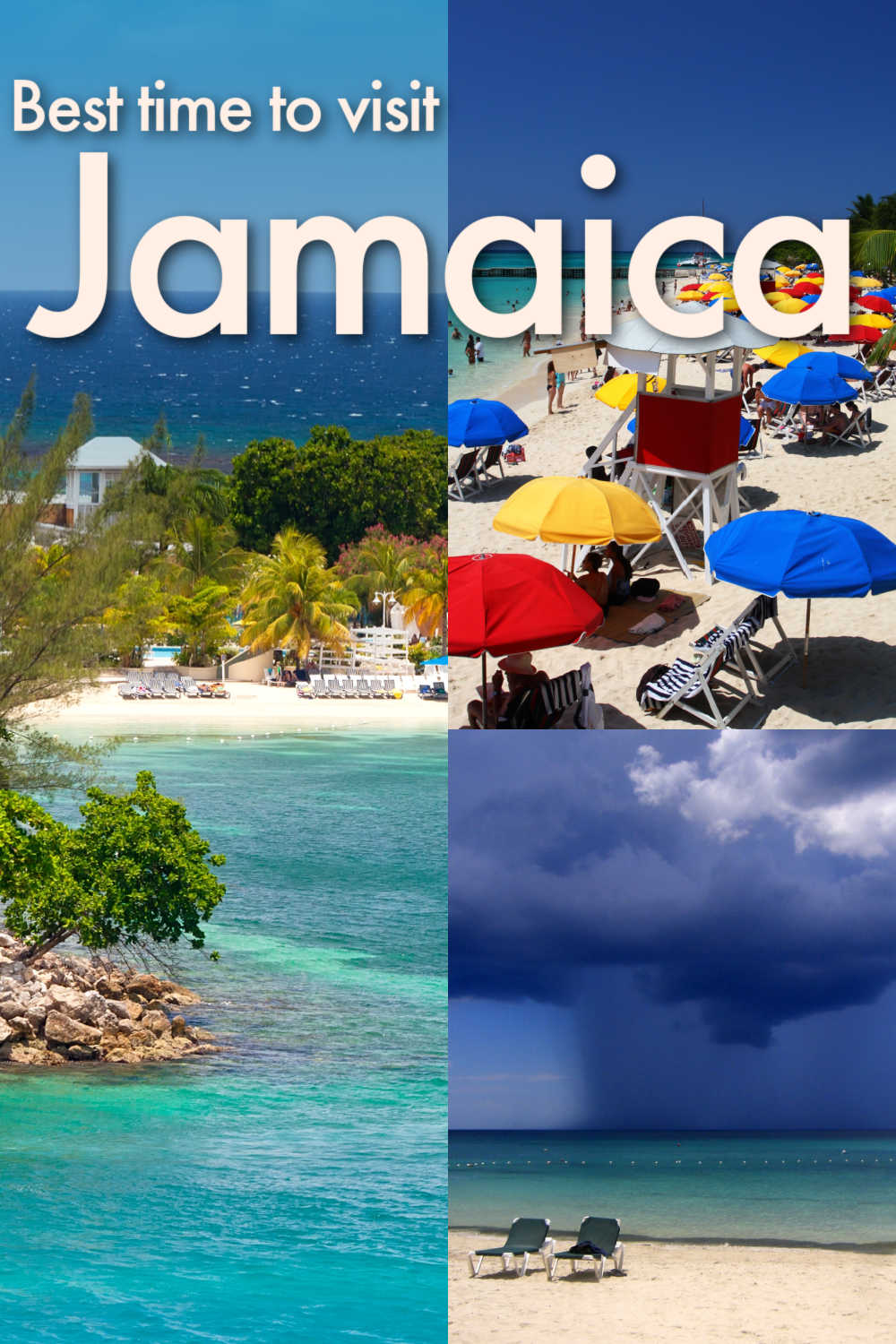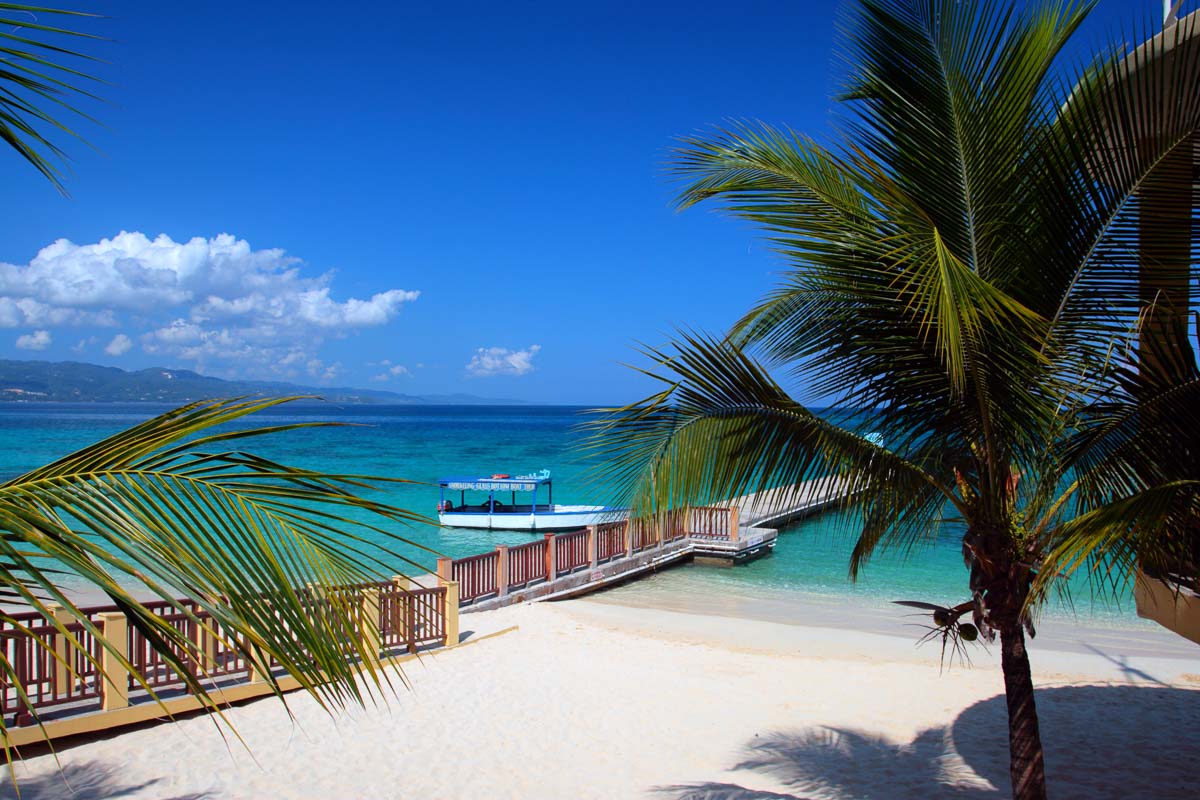
When is the best time to visit Jamaica? Find out here!
Table of Contents
Some of our links are affiliated, we will earn a commission when you buy a service or product. This will have no extra cost for you. For further info please refer to our Privacy Policy
There is no bad time to go to Jamaica, this stunning country is a great and warm travel destination all year round. However, you can make your Jamaica holiday way more enjoyable if you pick the right time to be there. So, when is the best time to visit Jamaica?
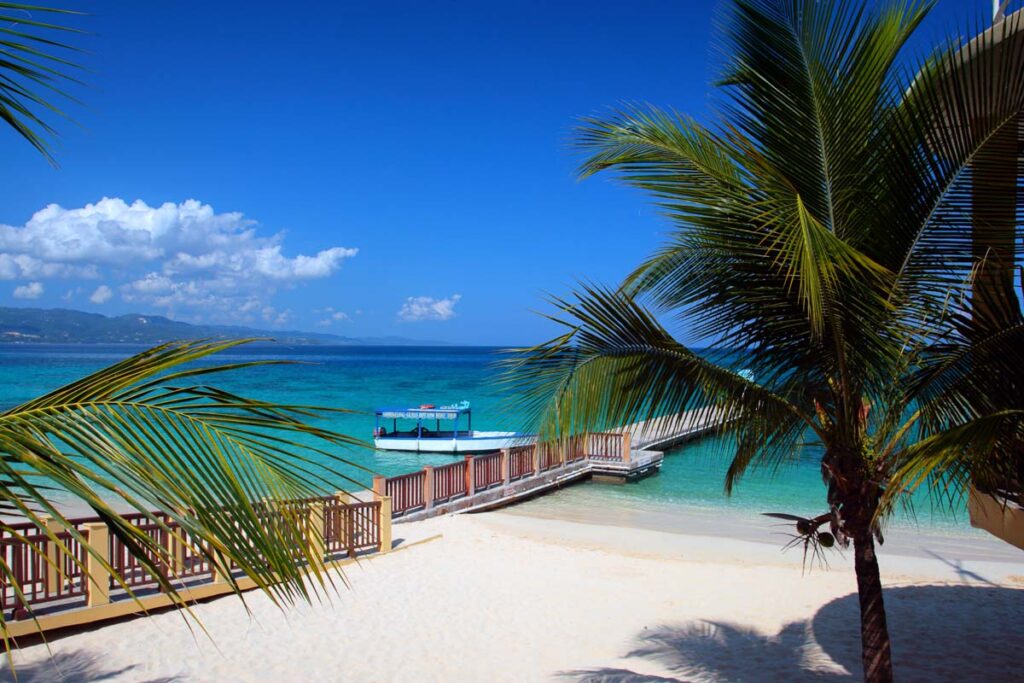
Most websites and weather platforms will tell you that the Jamaica traveling season is between November and May. But that is a generic answer. When planning your trip to Jamaica you must take into consideration Jamaican weather, places you want to visit, what you want to do, how much you want to spend, when are the peak, low, and hurricane seasons.
But don’t worry, planning the best time to travel to Jamaica is not that complicated, especially after reading this post. Our handy guide about when traveling to Jamaica covers all the essential topics, from Jamaica climate, the island seasons, the hurricane season, monthly temperatures in different areas of the country, and some tips to avoid the crowds and save some money.
Keep reading and I’m sure you will discover the ideal time to go to Jamaica and have a memorable beach vacation.
Traveling to Jamaica in 2022
Before we dive into all the details about the weather in Jamaica and the island festivities, let’s talk about traveling Jamaica now, in 2022. There are a couple of things you need to be aware of when booking your Jamaica vacation.
Due to the pandemic, many restrictions were put into place and it can be confusing to find the right information about who can visit Jamaica, travel requirements, and which safety protocols you must follow.

To make your trip to Jamaica as smooth as possible, here are a few trustworthy resources:
When is the best time to visit Jamaica?
To find out the best time to travel to Jamaica we need to look at the island’s temperatures, rainfall, hurricanes, low and peak seasons. We’ll be discussing all these details and by the end of this island guide, you’ll be able to choose your perfect time to travel to Jamaica.

Jamaica Climate
Jamaica has a warm tropical climate, which means that it is hot all year round. Jamaica’s average minimum temperature is 22ºC (73ºF) and maximum temperature is 31ºC (89ºF), and it doesn’t change much between winter and summer months. The changes of seasons are more related to rainfall, humidity, and hurricanes.
The good news is that it doesn’t matter the season, the sea is always warm, perfect for water sports and relaxation.
Jamaica Winter
There is no real winter in Jamaica as it never gets cold there. The winter months (December to March) are warm and dry, which means that they are the perfect sunny escape for European and Northern Americans that want to have a break from their icy winter.
The coldest month is January with temperatures reaching 20ºC (68ºF).
Jamaica Summer
Summer in Jamaica is from June to September, and they are the hottest and most humid months of the year. July is the hottest month in Jamaica with temperatures above 30ºC (87ºF).
Jamaica Spring and Autumn
Spring is a mix of Summer and Winter, with balmy weather and a slight increase in rain. On the other hand, Autumn is when the hurricane season happens.
Our advice for planning a holiday in Jamaica is to focus on the dry vs wet seasons as we’ll explain below. By doing so, you will be able to plan your trip better and find the best time to visit Jamaica.
Jamaica Dry Season and Jamaica Peak Season
There are two dry seasons in Jamaica, the longest one being from December to May (Winter and Spring) and the other one from July to August. The dry season means fewer days with rain and warm weather.
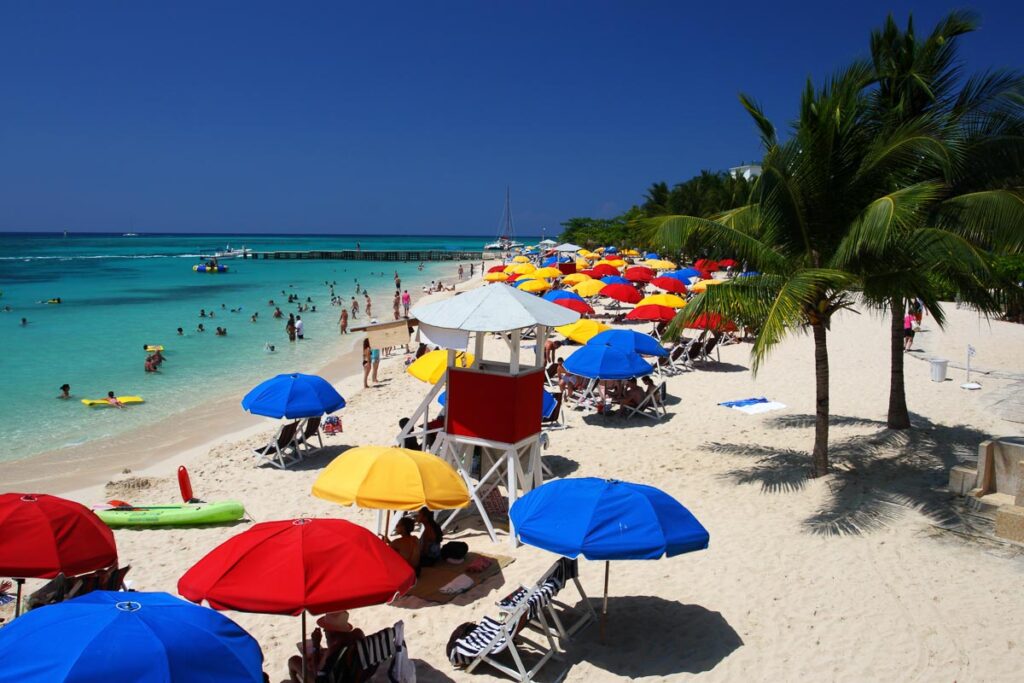
From December to March the average number of rainy days is 5 to 6 per month, the same for July. February is the driest month with an average of only 3 days of rain.
Of course, the dry months are also the peak season in Jamaica. The island sees an influx of tourists from mid-December to March, which means that it’s the busiest time and it’s the most expensive period to travel to Jamaica.
Christmas, New Year’s and Easter holidays are even busier. Keep in mind that March is the Spring break season and the island gets packed as well.
Jamaica’s peak season continues in April and May, but with a fewer number of tourists and bit more chances of rain. This is a great time of the year to combine good weather and good deals, as many all-inclusive resorts drop their prices.
Pros of visiting Jamaica during the dry season:
There will be less or no risk of rain.
You can explore the outdoors and beautiful beaches without worrying about rain.
Coldest temperatures of the year.
It’s the party season.
The hurricane season is over.
Cons of visiting Jamaica on the dry season:
Hotels, resorts, and beaches are packed with travelers.
Prices are higher and you must book your accommodation at least 3 months in advance.
For Christmas, New Year’s, and Easter it’s recommended to book your accommodation one year in advance, especially if you want to stay in an all-inclusive resort.
Rainy Season in Jamaica and Low Season in Jamaica
Some people call it the rainy season, others the wet season, but both mean that you will have warm temperatures and a high amount of tropical rainfall.
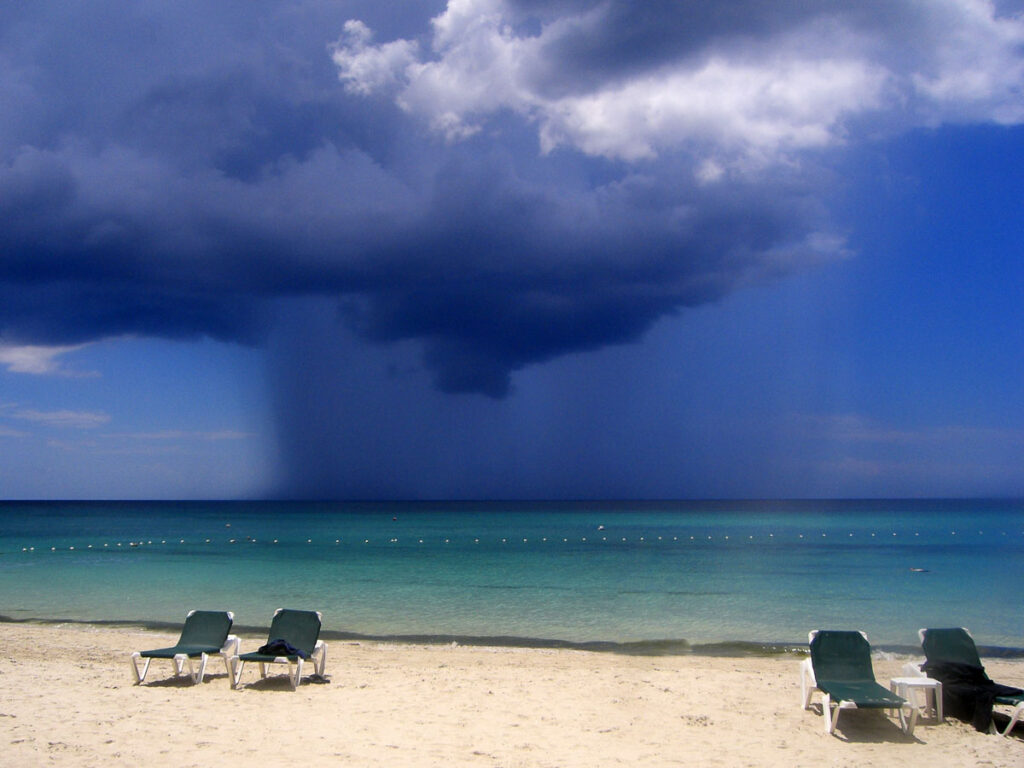
Jamaica’s rainy season happens at two different times of the year, the Spring rainy season is from May to June, and the Autumn rainy season is from September to November. The last one happens at the same time as the hurricane season – more about it below.
October is the rainiest month, with 14 days of rain.
The average rainfall can vary according to the island’s region. So when planning your trip to Jamaica keep in mind that September and October are the wettest months in Kingston and Ocho Rios, Montego Bay receives heavy storms and rain between September and December, and Negril’s wettest month is October.
Pros of visiting Jamaica on the wet season:
The tropical rainfall is not constant, there will be hours of sunshine.
It’s always warm.
It’s the low season, prices are cheaper and you can find great deals for hotels and activities.
There are fewer tourists and the places are quiet.
Cons of visiting Jamaica on the wet season:
Hot and humid weather.
The hottest temperatures of the year.
It might rain every day.
Many hotels and resorts can be under construction or renovation during this season.
Hurricane Season in Jamaica
Jamaica’s annual hurricane season is from June to November, being August and September the months that historically had more tropical storms, cyclones, and hurricanes. The good news is that Jamaica is not badly affected by tropical storms like other Caribbean islands, especially the ones located northerly.
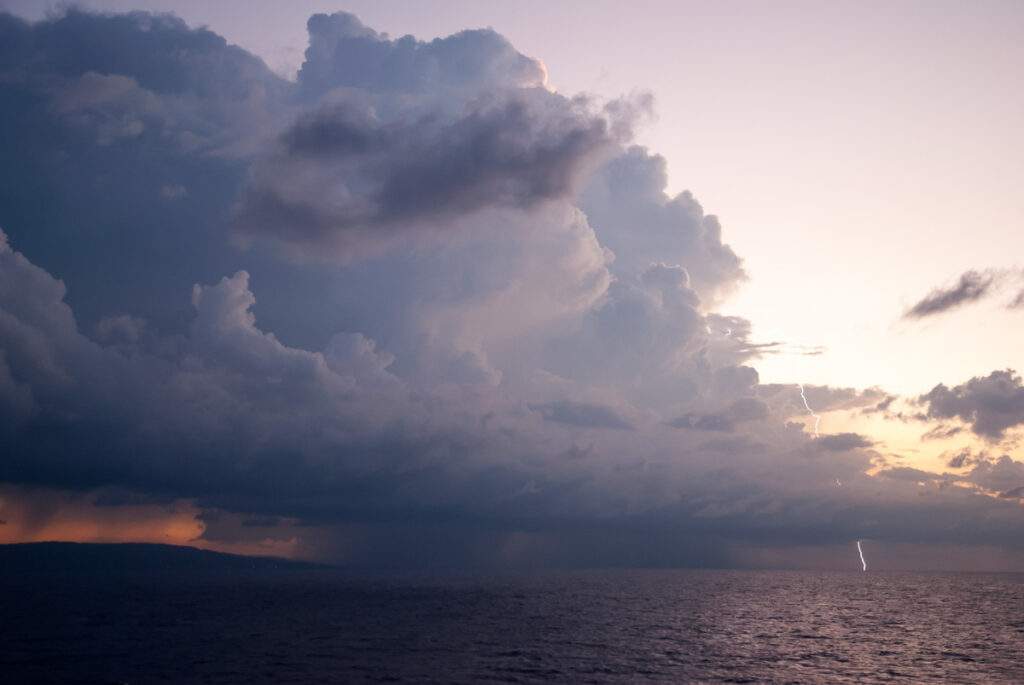
The data from the Meteorological Service of Jamaica shows that a few hurricanes hit the islands directly. What happens is that they cause a big increase in the rainfall, which is already high during those months.
Despite what many people think, there are tourists traveling to Jamaica during the hurricane season. Hotels and resorts usually offer big discounts during these months attracting travelers that want to save and are not bothered with the tropical rain.
For those inclined to travel to Jamaica during the peak hurricane season, our advice is to book a last-minute travel deal and keep an eye on the weather forecast. Also, read carefully the cancelation policy of your flights, accommodations, and activities. And don’t forget to buy comprehensive travel insurance. We recommend World Nomads, SafetyWing and HeyMondo. More about travel insurance here.
Pros of visiting Jamaica during the hurricane season:
The travel deals are great.
It’s always warm.
There are almost no tourists and the places are quiet.
Cons of visiting Jamaica during the hurricane season:
It’s hot and humid.
You might face heavy rain every day.
A hurricane or a tropical storm might happen.
Not all places are open.
Jamaica Shoulder Season
The period between the peak and low travel seasons is called shoulder season, and it can be one of the best times to visit Jamaica. The shoulder seasons go from mid-April to May, and from November to mid-December.
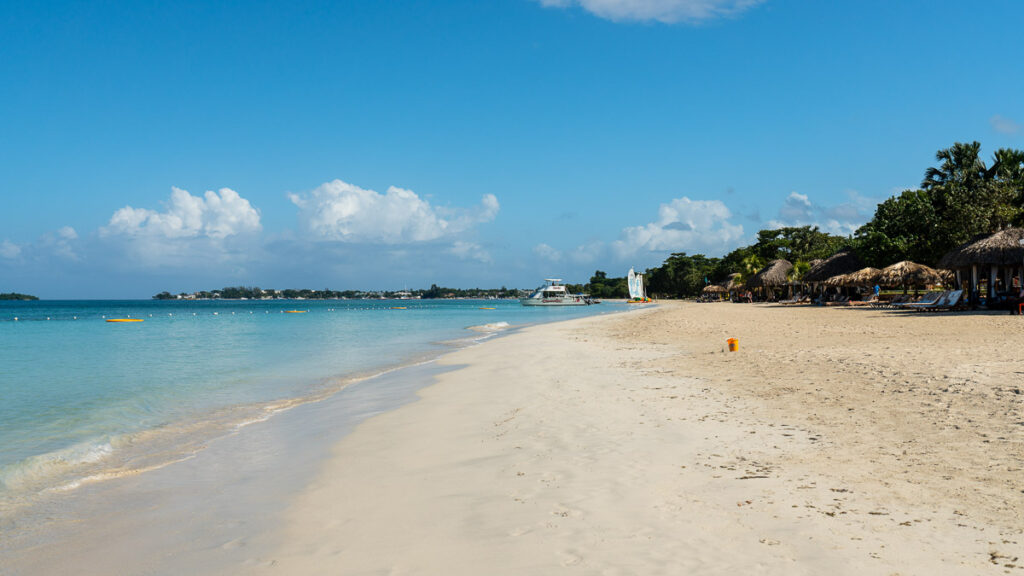
If you travel to Jamaica from mid-April to May you will find warmer temperatures and an increase in rain, but not as bad as during the wet months. The crowds are leaving the island so you can relax and enjoy it at a slower and more relaxed pace.
From mid-November, the hurricane season is almost over and you can visit Jamaica without the crowds that will arrive in the second half of December. During this period the number of rainy days starts to drop and most hotels and resorts have finished their renovations.
A few things to keep in mind about the shoulder season:
– If you want to save money, opt for visiting Jamaica between September and November, as they are not popular times yet.
– Jamaica’s Bacchanal Carnival season happens in April.
– Honeymooners like to travel to Jamaica between April and June.
Pros of visiting Jamaica on the shoulder season:
Warm daily temperatures.
It doesn’t rain that much.
You can find good hotel prices.
You can find good flight deals.
There are fewer tourists and the places are getting quiet, or starting to be busy.
Cons of visiting Jamaica on the shoulder season:
There aren’t many beach parties going on.
It rains more than the peak season.
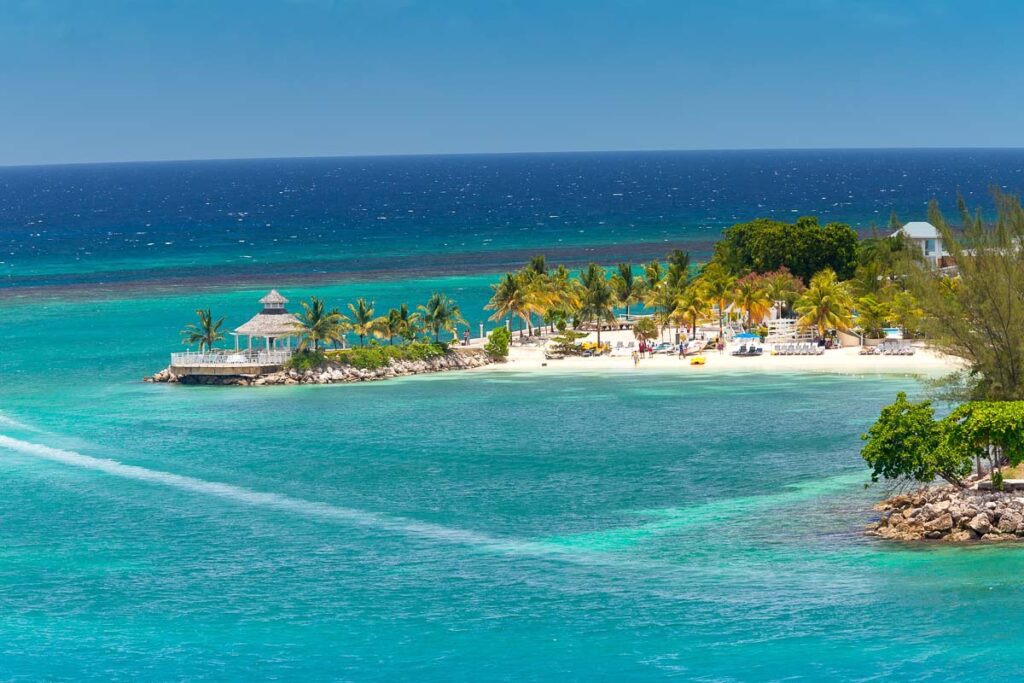
Jamaica Weather month by month guide
Here is a summary of the minimum and maximum temperatures in the major cities and major resort areas in Jamaica.
Weather in Jamaica in January
- January average temperature in Kingston: Min 19.2°C (66.5°F) Max 25.6°C (78°F)
- January average temperature in Montego Bay: Min 21°C (70°F) Max 30°C ( 86°F)
- January average temperature in Negril: Min 23.7°C (74.7°F) Max 28°C (82.3°F)
- January average temperature in Ocho Rios: Min 20.7°C (69.2°F) Max 25.9°C (78.6°F)
- January average rainfall in Kingston: 31 mm
- January average rainfall in Montego Bay: 52 mm
- January average rainfall in Negril: 19 mm
- January average rainfall in Ocho Rios: 76 mm
Weather in Jamaica in February
- February average temperature in Kingston: Min 19°C (66.1°F) Max 26.1°C (78.9°F)
- February average temperature in Montego Bay: Min 20.2°C (68.3°F) Max 27.8°C (82°F)
- February average temperature in Negril: Min 23.5°C (74.4°F) Max 28.3°C (83°F)
- February average temperature in Ocho Rios: Min 20.5°C (68.9°F) Max 26.5°C (79.7°F)
- February average rainfall in Kingston: 38 mm
- February average rainfall in Montego Bay: 47 mm
- February average rainfall in Negril: 21 mm
- February average rainfall in Ocho Rios: 53 mm
Weather in Jamaica in March
- March average temperature in Kingston: Min 19.2°C (66.6°F) Max 26.8°C (80.2°F)
- March average temperature in Montego Bay: Min 20.5°C (68.9°F) Max 28.6°C (83.5°F)
- March average temperature in Negril: Min 23.7°C (74.7°F) Max 28.7°C (83.7°F)
- March average temperature in Ocho Rios: Min 20.7°C (69.2°F) Max 27.2°C (80.9°F)
- March average rainfall in Kingston: 45 mm
- March average rainfall in Montego Bay: 68 mm
- March average rainfall in Negril: 30 mm
- March average rainfall in Ocho Rios: 63 mm
Weather in Jamaica in April
- April average temperature in Kingston: Min 20.1°C (68.3°F) Max 27.7°C (81.8°F)
- April average temperature in Montego Bay: Min 21.4°C (70.5°F) Max 29.4°C (84.8°F)
- April average temperature in Negril: Min 24.6°C (76.2°F) Max 29.5°C (85°F)
- April average temperature in Ocho Rios: Min 21.5°C (70.7°F) Max 28.1°C (82.6°F)
- April average rainfall in Kingston: 49 mm
- April average rainfall in Montego Bay: 103 mm
- April average rainfall in Negril: 40 mm
- April average rainfall in Ocho Rios: 60 mm
Weather in Jamaica in May
- May average temperature in Kingston: Min 21.3°C (70.3°F) Max 27.9°C (82.3°F)
- May average temperature in Montego Bay: Min 22.4°C (72.4°F) Max 29.6°C (85.3°F)
- May average temperature in Negril: Min 25.4°C (77.7°F) Max 29.7°C (85.4°F)
- May average temperature in Ocho Rios: Min 22.6°C (72.7°F) Max 28.7°C (83.6°F)
- May average rainfall in Kingston: 114 mm
- May average rainfall in Montego Bay: 226 mm
- May average rainfall in Negril: 102 mm
- May average rainfall in Ocho Rios: 110 mm
Weather in Jamaica in June
- June average temperature in Kingston: Min 22.2°C (71.9°F) Max 28.4°C (83.1°F)
- June average temperature in Montego Bay: Min 23.3°C (73.9°F) Max 30.4°C (86.8°F)
- June average temperature in Negril: Min 26.2°C (79.1°F) Max 30.2°C (86.3°F)
- June average temperature in Ocho Rios: Min 23.6°C (74.5°F) Max 29.7°C (85.4°F)
- June average rainfall in Kingston: 86 mm
- June average rainfall in Montego Bay: 155 mm
- June average rainfall in Negril: 77 mm
- June average rainfall in Ocho Rios: 53 mm
Weather in Jamaica in July
- July average temperature in Kingston: Min 22.3°C (72.2°F) Max 29.4°C (84.9°F)
- July average temperature in Montego Bay: Min 23.5°C (74.2°F) Max 30.7°C (87.3°F)
- July average temperature in Negril: Min 26.3°C (79.4°F) Max 30.5°C (87°F)
- July average temperature in Ocho Rios: Min 23.9°C (75°F) Max 30.6°C (87.1°F)
- July average rainfall in Kingston: 64 mm
- July average rainfall in Montego Bay: 143 mm
- July average rainfall in Negril: 73 mm
- July average rainfall in Ocho Rios: 47 mm
Weather in Jamaica in August
- August average temperature in Kingston: Min 22.5°C (72.5°F) Max 29.4°C (84.9°F)
- August average temperature in Montego Bay: Min 23.7°C (74.6°F) Max 30.6 °C (87.1°F)
- August average temperature in Negril: Min 26.5°C (79.8°F) Max 30.5°C (87°F)
- August average temperature in Ocho Rios: Min 24.1°C (75.3°F) Max 30.6°C (87.1°F)
- August average rainfall in Kingston: 93 mm
- August average rainfall in Montego Bay: 176 mm
- August average rainfall in Negril: 93 mm
- August average rainfall in Ocho Rios: 61 mm
Weather in Jamaica in September
- September average temperature in Kingston: Min 22.2°C (72°F) Max 28.8 °C (83.8°F)
- September average temperature in Montego Bay: Min 23.5°C (74.3°F) Max 30.1°C (86.1°F)
- September average temperature in Negril: Min 26.4°C (79.5°F) Max 30°C (86.1°F)
- September average temperature in Ocho Rios: Min 23.7°C (74.7°F) Max 30°C (86.1°F)
- September average rainfall in Kingston: 133 mm
- September average rainfall in Montego Bay: 212 mm
- September average rainfall in Negril: 118 mm
- September average rainfall in Ocho Rios: 88 mm
Weather in Jamaica in October
- October average temperature in Kingston: Min 21.7°C (71.1°F) Max 27.6°C (81.7°F)
- October average temperature in Montego Bay: Min 23.1°C (73.5°F) Max 29°C (84.2°F)
- October average temperature in Negril: Min 25.9°C (78.6°F) Max 29.2°C (84.6°F)
- October average temperature in Ocho Rios: Min 23.2°C (73.7°F) Max 28.7°C (83.6°F)
- October average rainfall in Kingston: 153 mm
- October average rainfall in Montego Bay: 190 mm
- October average rainfall in Negril: 112 mm
- October average rainfall in Ocho Rios: 129 mm
Weather in Jamaica in November
- November average temperature in Kingston: Min 20.8°C (69.5°F) Max 26.5°C (79.8°F)
- November average temperature in Montego Bay: Min 22.2°C (71.9°F) Max 27.8°C (82°F)
- November average temperature in Negril: Min 25.2°C (77.3°F) Max 28.6°C (83.6°F)
- November average temperature in Ocho Rios: Min 22.2°C (72°F) Max 27.1°C (80.7°F)
- November average rainfall in Kingston: 87 mm
- November average rainfall in Montego Bay: 98 mm
- November average rainfall in Negril: 40 mm
- November average rainfall in Ocho Rios: 120 mm
Weather in Jamaica in December
- December average temperature in Kingston: Min 20°C (68.1°F) Max 25.9°C (78.7°F)
- December average temperature in Montego Bay: Min 21.3°C (70.4°F) Max 27.4°C (81.3°F)
- December average temperature in Negril: Min 24.5°C (76°F) Max 28.3°C (83°F)
- December average temperature in Ocho Rios: Min 21.6°C (70.8°F) Max 26.4°C (79.5°F)
- December average rainfall in Kingston: 55 mm
- December average rainfall in Montego Bay: 61 mm
- December average rainfall in Negril: 40 mm
- December average rainfall in Ocho Rios: 100 mm
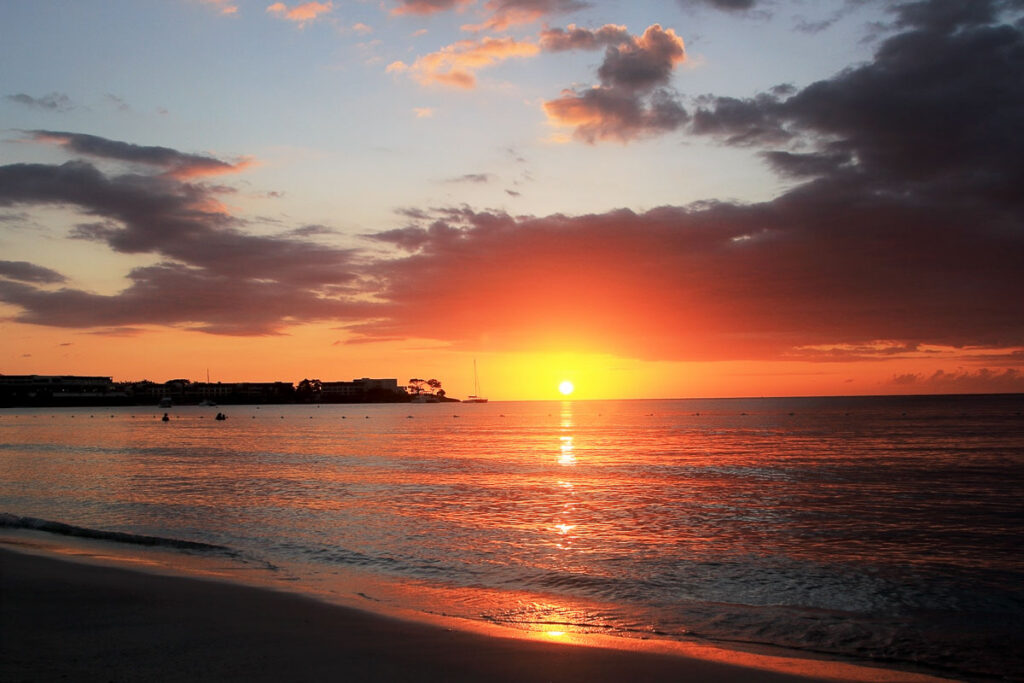
Jamaica Festivities
Cultural festivities can also help you choose the perfect time to visit Jamaica. Maybe you want to avoid the crowds, or you might be interested in joining one of Jamaica’s traditional celebrations, carnival, or a public holiday.
Below is a list of what happens in Jamaica by month, those are major events that have fixed dates. Be aware that due to the pandemic they might happen or not.
January
Accompong Maroon Festival, St. Elizabeth Parish.
February
- Bob Marley Week, Kingston.
- Bob Marley Birthday Bash, Negril.
- Reggae Summerfest, Montego Bay.
- Air Jamaica Jazz & Blues Festival, Montego Bay.
March
- Jamaica Kiteboard World Cup, Long Bay – Port Antonio.
- March Spring Break.
April
- Montego Bay Yacht Club’s Easter Regatta, Montego Bay.
- Carnival in Jamaica, Kingston, Ocho Rios, and Montego Bay.
May
- Calabash International Literary Festival, Treasure Beach.
- StyleWeek Jamaica & Fashion Block, Kingston.
June
- Kingston on the Edge Urban Art Festival (KOTE), Kingston.
- Caribbean Fashion Week, Kingston.
- Ocho Rios Jazz Festival, Ocho Rios and Montego Bay.
July
- Little Ochi Seafood Carnival, Alligator Pond.
- National Dance Theater Company’s Season of Dance, Kingston.
- Reggae Sumfest, Montego Bay.
August
- The Absolute Temptation Isle, Negril.
- Red Stripe Dream Weekend, Negril.
- The National Independence Float Parade and Grand Gala, Kingston.
September
- Falmouth Blue Marlin Tournament, Montego Bay.
October
- Port Antonio International Fishing Tournament, Port Antonio.
November
- Jamaica Food and Drink Festival, Kingston.
December
- Jamaica Food and Drink Festival, Kingston.
- Christmas Gran Market, St Catherine.
- Jonkanoo Masquerade Party.
When is the best time of year to visit Jamaica?
Now that you know everything about Jamaica’s weather and festivities, let’s summarize it. The best time to visit Jamaica can be divided into two categories: the peak season and the shoulder season.
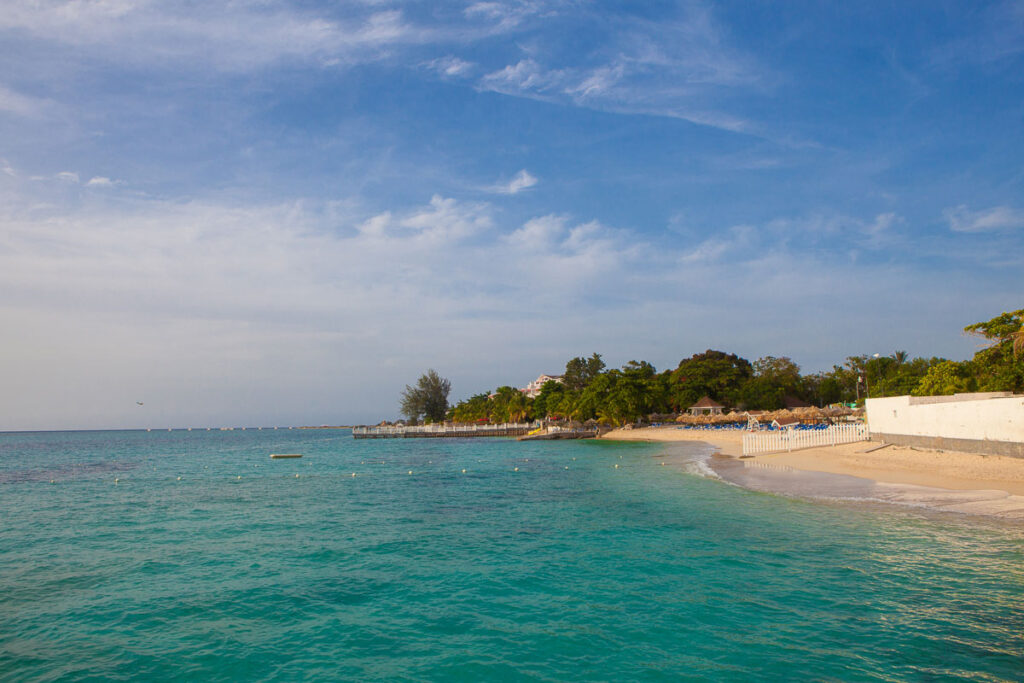
The peak tourist season is from mid-December to March (peak months), and the beginning of April.
The shoulder season will be from mid-April to May and from November to mid-December.
Why are these the best times to go to Jamaica?
The peak season will have sunny days and almost no rain. The island is in full swing and everything is happening. Most travelers go to Jamaica during this period (December to March).
The shoulder season has warm temperatures with a bit more rain, but you get better prices and hotel deals. Not to mention that this beautiful island is less crowded. During shoulder seasons (mid-April to May and from November to mid-December) you avoid the wet and humid months, and the hurricane season.
When is the cheapest time to visit Jamaica?
If the peak season is the most expensive time to go to Jamaica, the cheapest time to travel to Jamaica will be the low season, which means during the rainy months or the hurricane season. The cheapest months to go to Jamaica are September and October, being October the wettest month of the year.
But if you don’t mind facing some tropical storms once in a while, it can be a great option for saving money and visiting the island without the crowds of tourists.
Best time to travel to Jamaica round up
- Jamaica peak season: mid-December to March.
- Jamaica’s driest month: February, with an average of only 3 days of rain.
- Jamaica’s low season: July to October.
- Jamaica’s wettest month: October with an average of 14 days of rain.
- Jamaica’s hottest month: July.
- Jamaica’s coolest month: January.
- Jamaica shoulder seasons: mid-April to May and November to mid-December.
- Cheapest months to go to Jamaica: September and October.
- The best time to visit Jamaica: peak and shoulder seasons.
Are you planning to visit Jamaica in which season? Share your thoughts and we wish you an incredible holiday season on this paradise island.
Love this travel guide about the best time to visit Jamaica? Pin it for later!
